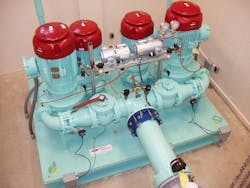Smith & Loveless Series Pumping System Solves Unique Challenge
In high-head wastewater pumping applications that result from long force mains or high-static heads from hilly terrains, a design engineer and end-user owner must evaluate numerous factors to efficiently overcome friction losses and achieve installation with reasonable capital costs.
Competitive bidding induces quoting the smallest horsepower pump at the highest speed. When the smaller pump is deficient in head, a larger pump is called for nearer to shut off. However, a dramatic reduction in efficiency likely occurs as it moves away from its best efficiency point. In these situations, use of vacuum-primed series pump arrangements help obtain higher pumping efficiencies, resulting in lower power costs and potentially smaller force mains.
Series pump arrangements differ from the parallel pumping arrangements seen in a typical duplex pump station, which comprise the duty pump and the stand-by pump. Pumps in series connect two pumps; where the outlet of the first pump leads to the inlet of the second pump. Working in concert, the flow rate still remains the same, but the heads produced by the two pumps are added.
Unlike typical submersible pumps, this unique series pump construction can be accomplished because the vertically constructed, non-clog pumps are housed outside the wet well – typically above-grade – and so each pump already comes designed with a suction flange. This enables the entire pump station to be above the wet well, thereby eliminating any need for extra valve vaults and the associated confined space concerns.
The bottom-line advantage gained in the series arrangement comes from selecting two smaller and more efficient pumps working in tandem to achieve the higher head. Even by adding the second pump, the total connected horsepower and/or resulting power consumption would still be less than what the larger single pump can achieve at the higher head.
